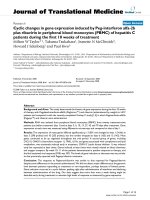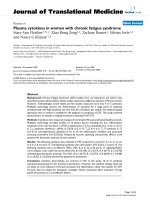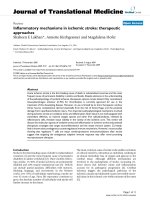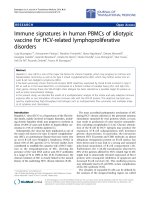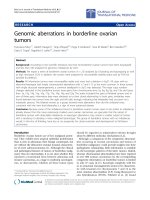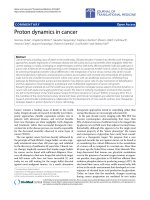Báo cáo hóa học: " Shell-Controlled Photoluminescence in CdSe/CNT Nanohybrids" ppt
Bạn đang xem bản rút gọn của tài liệu. Xem và tải ngay bản đầy đủ của tài liệu tại đây (441.77 KB, 7 trang )
NANO EXPRESS
Shell-Controlled Photoluminescence in CdSe/CNT Nanohybrids
Hua-Yan Si Æ Cai-Hong Liu Æ Hua Xu Æ
Tian-Ming Wang Æ Hao-Li Zhang
Received: 9 May 2009 / Accepted: 3 June 2009 /Published online: 14 June 2009
Ó to the authors 2009
Abstract A new type of nanohybrids containing carbon
nanotubes (CNTs) and CdSe quantum dots (QDs) was
prepared using an electrostatic self-assembly method. The
CdSe QDs were capped by various mercaptocarboxylic
acids, including thioglycolic acid (TGA), dihydrolipoic acid
(DHLA) and mercaptoundecanoic acid (MUA), which
provide shell thicknesses of *5.2, 10.6 and 15.2 A
˚
,
respectively. The surface-modified CdSe QDs are then self-
assembled onto aridine orange-modified CNTs via elec-
trostatic interaction to give CdSe/CNT nanohybrids. The
photoluminescence (PL) efficiencies of the obtained nano-
hybrids increase significantly with the increase of the shell
thickness, which is attributed to a distance-dependent
photo-induced charge-transfer mechanism. This work
demonstrates a simple mean for fine tuning the PL prop-
erties of the CdSe/CNT nanohybrids and gains new insights
to the photo-induced charge transfer in such nanostructures.
Keywords Carbon nanotubes Á CdSe Á Nanohybrids Á
Photoluminescence Á Charge transfer
Introduction
Recently, nanohybrids containing both semiconductor
quantum dots (QDs) and carbon nanotubes (CNTs) have
been the subject of great interest as a consequence of the
development of methods for the chemical modification of
CNTs and the seeking for novel functional materials [1–4].
Attachment of QDs onto conducting CNTs would place a
metallic wire in direct chemical contact with the QDs
surface. The metallic CNTs could then promote direct
charge transport and efficient charge transfer from the QDs
[5–8]. This system has the potential to significantly
increase the efficiency of photovoltaic devices [9, 10].
Besides, there has been an increasing interest on using
CNTs in biological system [11]. Attaching QDs onto CNT
can afford fluorescent labels and be utilized for detection,
imaging and cell sorting in biological applications [12].
For all the above applications, the understanding to how
the nanohybrid structure affects the charge transfer and
energy transfer behaviors between the QDs and CNT is
crucial. The interactions between II–VI QDs (such as CdS,
CdSe and CdTe) and CNTs have been investigated by
several groups [8, 13–15]. The charge-transfer efficiencies
were evaluated by studying the changes in the photolumi-
nescence (PL) [13, 16, 17] or photo-electrochemical
properties of such hybrid materials [8, 14, 15, 18]. The PL
behaviors of the nanohybrids were found to be strongly
dependent on how the QDs are attached to the CNTs. For
example, strong PL quenching by charge-transfer mecha-
nism were reported for the CdS/TOAB/CNT [8], CdSe/
pyridine/CNT [19] and CdSe/pyrene/CNT systems [20].
Partial emission quenching was observed on nanohybrids
consisting of dendron-modified CdS QDs on CNT [21]. In
contrast, Giersig [22,
23] reported preserved CdTe PL by
insulating the CNTs using silica coating. The previous
works have shown that the PL properties of the QD/CNT
nanohybrids are strongly dependent on QD-CNT separa-
tion, but precise control to the distance between QDs and
CNT was difficult to achieve in the available systems.
In this work, a facile strategy toward novel CdSe/CNT
nanohybrids with tunable QDs-CNT separation is pre-
sented (Scheme 1). In this method, the CdSe QDs are
H Y. Si Á C H. Liu Á H. Xu Á T M. Wang Á H L. Zhang (&)
State Key Laboratory of Applied Organic Chemistry,
College of Chemistry and Chemical Engineering,
Lanzhou University, 730000 Lanzhou, China
e-mail:
123
Nanoscale Res Lett (2009) 4:1146–1152
DOI 10.1007/s11671-009-9373-z
capped by different mercaptocarboxylic acids. The mer-
captocarboxylic acids provide both necessary surface
functionality and well-controlled shell thickness. The
CNTs are noncovalently functionalized by positively
aromatic molecules [24]. The CdSe QDs are then self-
assembled onto the functionalized CNTs through electro-
static interaction to afford stable nanohybrids in aqueous
solution. By using different mercaptocarboxylic acids, the
average distance between QDs and CNTs in the CdSe/CNT
nanohybrids can be readily adjusted within angstrom level
precision. The obtained CdSe/CNT nanohybrids provide a
well-defined system to study the effects of CdSe–CNT
separation on their optical properties.
Experiment
Mercaptocarboxylic Acids Modified CdSe QDs
Trioctylphosphine oxide (TOPO)-capped CdSe QDs were
prepared as reported previously [25]. The QDs were then
modified by mercaptocarboxylic acids through a ligand-
exchange reaction as described below. The thioglycolic
acid (TGA) was diluted to 1 M with PBS (pH = 7.4)
buffer. The TGA solution (3 mL) was added to the solution
TOPO/CdSe, which was dissolved in 1 mL of chloroform.
The mixture was stirred for 2 in dark and then separated
into two layers spontaneously. The water layer was
extracted and centrifuged to produce a pellet of TGA-
capped QDs (TGA-CdSe). The supernatant, which contains
free TGA, was discarded. Dihydrolipoic acid (DHLA)-
capped CdSe QDs (DHLA-CdSe) were prepared as
reported previously [26]. The mercaptoundecanoic acid
(MUA)-capped CdSe QDs (MUA-CdSe) was prepared in a
similar way as the TGA-CdSe, except that MUA was dis-
solved in ethanol. The mercaptocarboxylic acids modified
CdSe QDs were purified by three cycles of filtration using
membrane separation filters followed by washing with
MilliQ ultra-pure water. Small amount of potassium tert-
butoxide was added to the CdSe QDs solution to improve
the solubility in water and also turn the QDs into a nega-
tively charged state.
Aridine Orange-Modified CNT
Multiwall CNTs were purified in 37% HCl. The purified
CNTs were then noncovalently modified with aridine
orange (AO), following the processes described in our
previous work [24]. The molecular structure of AO is
shown in Scheme 1. In a typical process, 2.0 mg purified
CNTs were added to an aqueous solution containing 2 mg
AO and sonicated at room temperature for at least 2 h to
reach a maximum adsorption. The AO-modified CNTs
(AO/CNTs) were separated from the solution by filtration
using a 0.22-lm diameter cellulose acetate–cellulose
nitrate membrane, and then thoroughly rinsed to remove
access AO.
CdSe/CNT Nanohybrids
The aqueous solutions of CdSe QDs were then titrated with
AO/CNT solution and gently stirred to give the CdSe/CNT
nanohybrids. The produced nanohybrids were subjected to
three washing cycles to remove the excess CdSe QDs. In
each washing cycle, the samples were centrifuged at
4,000 rpm for 3 min then redispersed in PBS buffer after
removing the supernatant.
Results and Discussions
The CNTs were first modified by AO molecules via p–p
stacking. The interaction between CNTs and different
organic dyes has been investigated in our previous
Scheme 1 Schematic illustration to the structures of the CdSe/CNT
nanohybrids prepared by electrostatic assembly (left). The photo-
induced charge-transfer efficiency within the nanohybrids is con-
trolled by the shell thickness. Energy-level diagram and possible
charge-transfer process for the conjugate complex between CdSe QDs
and semiconducting CNTs (s-CNT) or metallic CNTs (m-CNT) are
illustrated in the right
Nanoscale Res Lett (2009) 4:1146–1152 1147
123
work [24]. Positively charged AO shows high affinity to
CNTs and strongly improved the dispersibility of CNTs in
aqueous solution. After being functionalized by AO, the
CNTs can be readily dispersed in aqueous medium to form
stable suspensions. Figure 1a and b shows the typical TEM
images of CNTs before and after the modification by AO.
Figure 1b suggests that most of the AO functionalized
nanotubes are in less entangled state than the unmodified
CNTs. The topographies of the CNTs after interaction with
different CdSe QDs are shown in Fig. 1c–e. The TEM
micrographs indicate that QDs and the modified CNTs
coexist in the proximity of each other. The increased
entanglement of the nanotubes compared with that of AO/
CNTs (Fig. 1b) could be attributed to the strong electro-
static interactions between the negatively charged quantum
dots and the AO functionalized CNTs. The coverage of the
QDs on the CNTs appears to be not very uniform, sug-
gesting that the positive charge on the CNT surface is not
very uniform. This nonuniformity may be attributed to the
defects on the CNTs. The CNT samples were purified in
acid before AO modification, and therefore contain many –
CHO, –OH and –COOH groups (as shown in the IR data
below). These groups, especially –COOH, may interact
with the AO molecules and partially neutralize the positive
charges and induce a nonuniformed distribution of surface
charge.
The bonding between the mercaptocarboxylic acid-
capped CdSe QDs, and the AO/CNTs was first studied by
comparing their XRD patterns (Fig. 2). The AO/CNT
sample produces two typical peaks at 26.06° and 44.46°,
which are attributed to the (002) and (100) planes of CNTs
[27] (Fig. 2a). The CdSe/CNT composite gives broad
peaks at 22°, 25.6°, 26.8°,42° and 49.6°, attributed to the
(100), (002), (101), (102) and (112) planes of the hexag-
onal phase CdSe (close to PCPDFWIN 77-2307), respec-
tively. The (100), (002) and (101) peaks of the CdSe QDs
are partly overlapped with the (002) peak of the oxidized
CNTs, therefore are difficult to be identified (Fig. 2b). No
peak corresponding to impurities is detected. The CdSe
peaks in the XRD patterns of the CdSe/CNT nanohybrids
Fig. 1 TEM micrographs of
a The purified CNTs, b AO/
CNTs, c TGA-CdSe/CNT,
d DHLA-CdSe/CNT and
e MUA-CdSe/CNT
Fig. 2 XRD patterns ofa AO/CNTs and b TGA-CdSe/CNT nanohybrids
1148 Nanoscale Res Lett (2009) 4:1146–1152
123
are all very broad (Fig. 2b), which is attributed to the small
size of the CdSe QDs. The XRD data are in support of the
successful attachment of the hexagonal phase of CdSe QDs
to the surface of CNTs. Similar observations were
found for the DHLA-CdSe/CNT and MUA-CdSe/CNT
nanohybrids.
FT-IR spectra also confirm the formation of CdSe/CNT
nanohybrids. Due to the surface oxidation, the acid-treated
CNTs show characteristic peak of C=O stretching at 1,630,
corresponding to oxidized spices, such like –COOH and
–CHO (Fig. 3a). The presence of AO on the AO/CNTs is
evident by a series of absorption bands in the regions of
1,000–1,500 cm
-1
, which are consistent with the charac-
teristic peaks of AO in this region (Fig. 3b). The TOPO/
CdSe shows a strong band around 1,100 cm
-1
due to the
P=O stretch of the TOPO ligand [28] (Fig. 3c). Evidence of
that the QDs are capped with TGA comes from the pres-
ence of a strong –COOH peak at 1,680 cm
-1
and vanish of
the P=O stretch band around 1,100 cm
-1
(Fig. 3d), indi-
cating that the desired ligand exchange occurred on the QD
surface. Assembly of TGA-CdSe QDs onto the AO/CNTs
results in the appearance of a new peak at 1,730 cm
-1
,
and the vibrational mode at 1,580 cm
-1
on the TGA-CdSe
nanoparticles shifts to 1,550 cm
-1
(Fig. 3e), revealing the
interactions between the carboxylate group on TGA-CdSe
and the pyridine ring of the AO molecules on the CNTs.
The interaction between the CNTs and the QDs can be
ascribed to the electrostatic interaction between the posi-
tively charged AO moieties and the carboxylate groups
[29]. Because the AO molecule has a pK
b
of 7.2, the AO/
CNTs should show positive surface charge under slightly
acidic conditions. The mercaptocarboxylic acid on the
CdSe QDs could afford negatively charged carboxylate
groups, hence could associated with the AO moieties on the
CNTs to yield CdSe/CNT nanohybrids. Even when both
are initially in the neutral state, acid–base reaction could
take place between the AO and surface-bound acids.
Similar observations were also found for the DHLA-CdSe/
CNT and MUA-CdSe/CNTs nanohybrids.
To probe the interaction between QDs and CNTs, we
titrated the aqueous solutions of DHLA-CdSe with the AO/
CNT solution and monitored the changes in the charac-
teristic band gap transitions of CdSe in both absorption and
PL spectra. In the absorption spectra, the features of CNT
unequivocally emerge during the titration. A consistent
trend in all of these titration curves is a shift of the CdSe
absorption edge around 580 nm toward higher transition
energies reaching a few nanometers. In the PL spectra, the
addition of CNT solutions leads to nonlinear quenching
effects of the strong CdSe-centered emission around
560 nm (Fig. 4). Strong electronic interactions, such as
transfer of charge density between the electroactive com-
ponents, are likely to be responsible for the aforementioned
effects, i.e., the blue shift in absorption edge and PL
quenching.
The changes in the CdSe/CNT absorption and the PL
spectra can be understood by the photo-induced charge
transfer within the nanohybrids (Scheme 1). The valence
band and conduction band energy levels for the as-prepared
CdSe QDs are taken to be 6.2 and 3.9 eV, respectively
[30]. The semiconducting CNTs normally have an energy
gap ranging from 0 to 1.1 eV, and the Fermi level of the
metallic CNTs is taken to be 4.5–5.0 eV [31, 32]. The PL
of the QDs is due to the radiative decay path from their
excited state to ground state [14]. Given that the nanotubes
quenched the CdSe QDs, the QD-CNT interaction must
provides an alternative nonradiative decay path. It is
believed that this nonradiative decay path occurs because
the difference in electron affinity between the CdSe QDs
and the CNTs is sufficient to allow electron transfer from
the QDs to the CNTs [19]. Based on the energy diagram,
the formation of CdSe/CNT conjugates favors the electron
transfer from the QDs (donor) to the CNTs (acceptor) such
that the excited electrons moved to the CNTs rather than be
emitted as the PL peak. Thus, the electrons of the excitons
could be partially transferred to CNTs by an electron-
injection mechanism, while the remaining electrons exhibit
a reduced emission by an electron-hole recombination
process.
As the titration experiment shows that the amount of the
added CNTs strongly affects the absorption and PL prop-
erties of the CdSe QDs, the spectra of the three CdSe/CNT
nanohybrids were measured in the presence of little excess
CNTs. Figure 5 shows the UV–vis absorption and PL
spectra of the aqueous suspensions of the different CdSe
QDs and the CdSe/CNT nanohybrids. Figure 5a shows the
characteristic exciton absorption peaks at 550, 540, 560 nm
for the TGA-CdSe, DHLA-CdSe and MUA-CdSe QDs,
respectively, which are corresponding to their first
Fig. 3 FT-IR spectra of a Acid-purified CNTs, b AO/CNTs,
c TOPO-CdSe QDs, d TGA-CdSe QDs and e TGA-CdSe/CNT
nanohybrids
Nanoscale Res Lett (2009) 4:1146–1152 1149
123
Fig. 4 The UV–vis absorption (a) and photoluminescence spectra (under excitation at 400 nm) (b) of CdSe QDs upon addition of AO/CNTs.
The insert of (a) shows the slight blue shift of the CdSe absorption edge during titration
Fig. 5 a UV–vis absorption
and b photoluminescence
spectra of aqueous CdSe QDs.
c UV–vis absorption and
d photoluminescence spectra of
the CdSe/CNT nanohybrids.
e–g Are the optical and
photoluminescence images
(365 nm irradiation) of the
nanohybrids suspensions. The
curves are offset for clarity
1150 Nanoscale Res Lett (2009) 4:1146–1152
123
electronic transition. The small variation in the exciton
peak positions in the three QDs is attributed to the small
difference in the average particle sizes. This size variation
is relatively small and should not affect our further dis-
cussions. The TGA-CdSe, DHLA-CdSe and MUA-CdSe
QDs show strong PL peaks at 570, 560 and 580 nm,
respectively (Fig. 5b). The PL spectra of the CdSe/CNT
nanohybrids reveal an additional luminescence feature at
520 nm, corresponding to the emission from the AO mol-
ecules (Fig. 5d). The existence of this characteristic AO
peak confirms the presence of AO on the CNT sidewalls
[24]. After forming the CdSe/CNT hybrid, the absorption
peaks of the QDs are slightly blue-shifted and broadened
(Fig. 5c). The intensity of the QD peaks were also reduced
compared to that in free states. In previous studies on the
CdTe and CdSe QDs that were covalently attached to
CNTs [1, 33], no QD absorption band was observed due to
the broad background absorption of the CNTs. In our work,
although the CNT background seems to be strongly
screening the absorption of the QDs, the QD absorption
edge around 550–580 nm can still be distinguished
(Fig. 5c), which can only be explained by a dense coating
of relatively monodisperse QDs onto the CNTs [23].
As mentioned above, the different mercaptocarboxylic
acid coatings provide different shell thicknesses for the
CdSe QDs. The PL spectra show that the intensity of the
QD emission peaks in the CdSe/CNT nanohybrids is
strongly dominated by the shell thickness. The PL of the
TGA-CdSe QDs is nearly completely vanished after
binding with the CNTs. The PL of the DHLA-CdSe QDs is
dramatically reduced to a moderate intensity, indicating
partial quenching occurred. In contrast, the PL intensity of
the MUA-CdSe QDs remains nearly unchanged in the
presence of the CNTs (Fig. 5d) and showing no obvious
quenching occurs. The different PL intensities of the CdSe/
CNT nanohybrids suspensions are visible to naked eyes in
the fluorescent images of the nanohybrid solution. As seen
in Fig. 5e–g, under UV irradiation, the PL brightness
increases with the chain length of the capping mercapto-
carboxylic acids on the CdSe QDs.
As demonstrated in Fig. 5, the fluorescence of the CdSe/
CNT is well controlled by the length of the organic spacers.
In a similar fashion, Kulakowich et al. [34] studied the
optical effects of tuning the separation between gold col-
loids and QDs on planar substrates. A clear increase of the
PL has been observed as the separation increased. In our
strategy, the separation between the QDs and CNTs is
adjusted by the lengths of alkyl chains of the capping
agents. The fully extended lengths of TGA, DHLA and
MUA are 5.2, 10.6 and 15.2 A
˚
, respectively, as estimated
from semi-empirical (PM3) calculations. Assuming that the
AO molecules are adsorbed on the CNT sidewalls with a
coplanar configuration and using the normal van der Waals
diameter values for the AO and carboxylic acids, the sep-
aration between the edges of the CdSe QDs and CNTs are
estimated to be around 14, 19 and 24 A
˚
for the TGA-CdSe/
CNT, DHLA-CdSe/CNT and MUA-CdSe/CNT systems,
respectively. As the average distance between the CdSe
QDs and CNTs increases within 10 A
˚
ranges, the PL
properties of the CdSe/CNT change from total quenching
to nearly no quenching. This result clearly demonstrates
that a precise control to the QD-CNT spacing at angstrom
level is essential for controlling the PL properties of the
CdSe/CNT nanohybrids.
Conclusions
We report a new and facile method for attaching CdSe QDs
onto CNT surface by electrostatic self-assembly. By using
different mercaptocarboxylic ligands, the shell thicknesses
of the CdSe QDs are well controlled within angstrom-
level precision. The formation of various CdSe/CNT
nanohybrids has been confirmed by TEM, XRD, FT-IR,
UV–vis absorption and PL spectroscopies. The absorption
and PL spectra of the hybrid materials suggested that
photo-induced electron transfer from CdSe QDs to CNTs
took place in the nanohybrids. The efficiency of the PL
quenching decreases upon increasing the shell thickness
due to the distance-dependent electron transfer efficiency.
This work demonstrates that the shell thickness control to
the QDs opens up a straightforward methodology for
investigating the interaction between fluorescent nanoma-
terials coupled with CNTs. Since there is large number of
bifunctional ligands readily available for researchers, this
method can be used as a general approach to tailor the
QD-CNT separation within molecular size range. The
ability to allow or prevent charge transfer from photoex-
cited QDs to CNT provides a useful technique in devel-
oping QDs/CNT nanomaterials to become flexible, facile
building blocks for many practical applications, including
electrooptic devices, biological nanoprobes for cytological
investigation and in situ fluorescently detectable
microsensors.
Acknowledgments The authors are grateful to the financial support
from the program for New Century Excellent Talents in University
(NCET), National Natural Science Foundation of China (NSFC.
20503011, 20621091), Specialized Research Fund for the Doctoral
Program of Higher Education (SRFDP. 20050730007), and Key
Project for Science and Technology of the Ministry of Education of
China (106152).
References
1. J.M. Haremza, M.A. Hahn, T.D. Krauss, Nano Lett. 2, 1253
(2002)
Nanoscale Res Lett (2009) 4:1146–1152 1151
123
2. S. Banerjee, S.S. Wong, Nano Lett. 2, 195 (2002)
3. S. Agrawal, A. Kumar, M.J. Frederick, G. Ramanath, Small 1,
823 (2005)
4. B.R. Azamian, K.S. Coleman, J.J. Davis, N. Hanson, M.L.H.
Green, Chem. Commun. 4, 366 (2002)
5. B.J. Landi, S.L. Castro, H.J. Ruf, C.M. Evans, S.G. Bailey,
R.P. Raffaelle, Sol. Energy Mater. Sol. Cells 87, 733 (2005)
6. G.M.A. Rahman, D.M. Guldi, E. Zambon, L. Pasquato, N. Tag-
matarchis, M. Prato, Small 1, 527 (2005)
7. S. Ravindran, S. Chaudhary, B. Colburn, M. Ozkan, C.S. Ozkan,
Nano Lett. 3, 447 (2003)
8. I. Robel, B.A. Bunker, P.V. Kamat, Adv. Mater. 17, 2458 (2005)
9. D.M. Guldi, I. Zilbermann, G. Anderson, N.A. Kotov, N. Tag-
matarchis, M. Prato, J. Mater. Chem. 15, 114 (2005)
10. P.V. Kamat, J. Phys. Chem. C 111, 2834 (2007)
11. N.N. Ratchford, S. Bangsaruntip, X.M. Sun, K. Welsher, H.J.
Dai, J. Am. Chem. Soc. 129, 2448 (2007)
12. S. Chaudhary, J.H. Kim, K.V. Singh, M. Ozkan, Nano Lett. 4,
2415 (2004)
13. W. Li, C. Gao, H. Qian, J. Ren, D. Yan, J. Mater. Chem. 16, 1852
(2006)
14. D.M. Guldi, G.M.A. Rahman, V. Sgobba, N.A. Kotov, D. Bon-
ifazi, M. Prato, J. Am. Chem. Soc. 128, 2315 (2006)
15. L. Sheeney-Haj-Ichia, B. Basnar, I. Willner, Angew. Chem. Int.
Ed. 44, 78 (2005)
16. V. Biju, T. Itoh, Y. Baba, M. Ishikawa, J. Phys. Chem. B 110,
26068 (2006)
17. B.F. Pan, D.X. Cui, C.S. Ozkan, M. Ozkan, P. Xu, T. Huang, F.T.
Liu, H. Chen, Q. Li, R. He, F. Gao, J. Phys. Chem. C 112, 939
(2008)
18. J.M. Du, L. Fu, Z.M. Liu, B.X. Han, Z.H. Li, Y.Q. Liu, Z.Y. Sun,
D.B. Zhu, J. Phys. Chem. B 109, 12772 (2005)
19. Q.W. Li, B.Q. Sun, I.A. Kinloch, D. Zhi, H. Sirringhaus, A.H.
Windle, Chem. Mater. 18, 164 (2006)
20. L.B. Hu, Y.L. Zhao, K.M. Ryu, C.W. Zhou, J.F. Stoddart, G.
Gru
¨
ner, Adv. Mater. 20, 939 (2008)
21. S.H. Hwang, C.N. Moorefield, P.S. Wang, K.U. Jeong, S.Z.D.
Cheng, K.K. Kotta, G.R. Newkome, J. Am. Chem. Soc. 128,
7505 (2006)
22. M. Olek, T. Busgen, M. Hilgendorff, M. Giersig, J. Phys. Chem.
B 110, 12901 (2006)
23. M. Grzelcaak, M.A. Correa-Duarte, V. Salgueirino-Maceira, M.
Giersig, R. Diaz, L.M. Liz-Marzan, Adv. Mater. 18, 415 (2006)
24. C.H. Liu, J.J. Li, H.L. Zhang, B.R. Li, Y. Guo, Colloids Surf. A
Physicochem. Eng. Asp. 313–314, 9 (2008)
25. H.Y. Si, Z.H. Sun, H.L. Zhang, Colloids Surf. A Physicochem.
Eng. Asp. 313–314, 604 (2008)
26. H.T. Uyeda, I.L. Medintz, J.K. Jaiswal, S.M. Simon, H. Mat-
toussi, J. Am. Chem. Soc. 127, 3870 (2005)
27. M. Terrones, W.K. Hsu, A. Schilder, H. Terrones, N. Grobert,
J.P. Hare, Y.Q. Zhu, M. Schwoerer, K. Prassides, H.W. Kroto,
D.R.M. Walton, Appl. Phys. A 66, 307 (1998)
28. M.J. Eilon, T. Mokari, U.J. Banin, J. Phys. Chem. B 105, 12726
(2001)
29. Z.X. Cai, X.P. Yan, Nanotechnology 17, 4212 (2006)
30. M. Gratzel, Nature 414, 338 (2001)
31. S. Kazaoui, N. Minami, N. Matsuda, Appl. Phys. Lett. 78, 3433
(2001)
32. M. Shiraishi, M. Ata, Carbon 39, 1913 (2001)
33. S. Barnerjee, S.S. Wong, Adv. Mater. 16, 34 (2004)
34. O. Kulakowich, N. Strekal, A. Yaroshevich, S. Maskevich, S.
Gaponenko, I. Nabiev, U. Woggon, M. Artemyev, Nano Lett. 2,
1449 (2002)
1152 Nanoscale Res Lett (2009) 4:1146–1152
123
